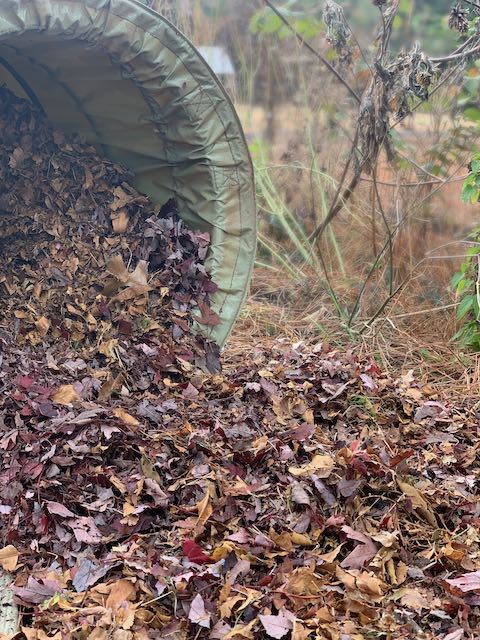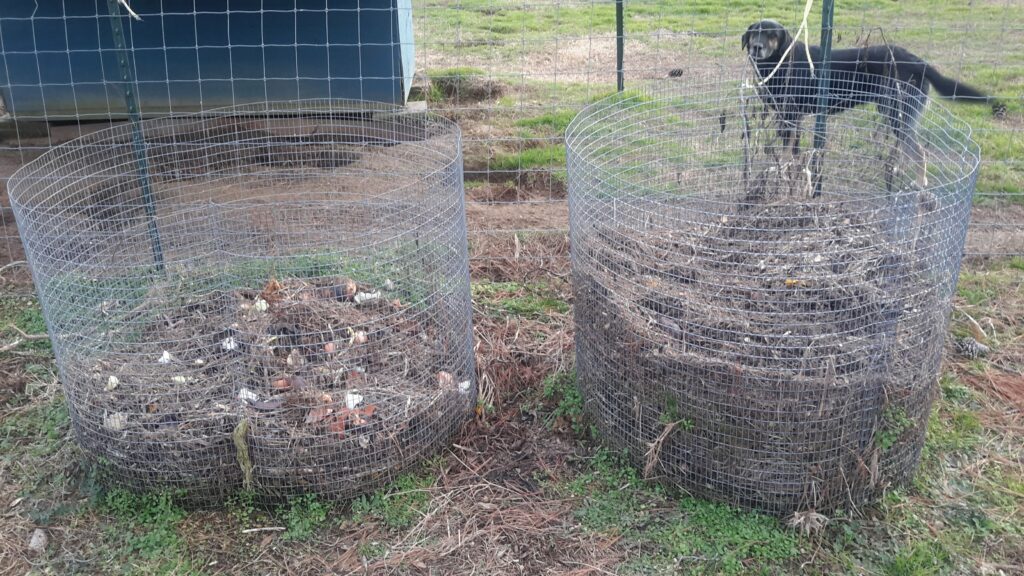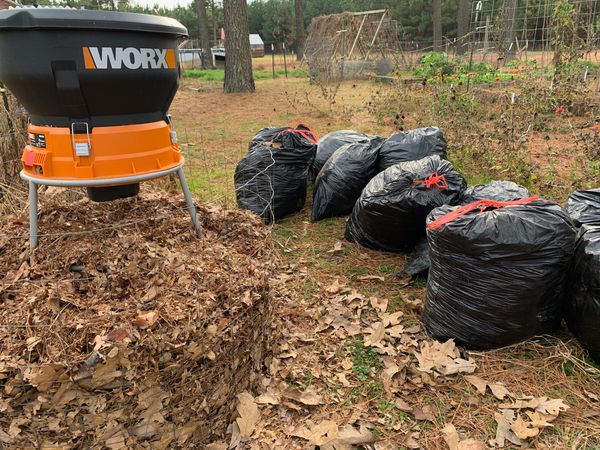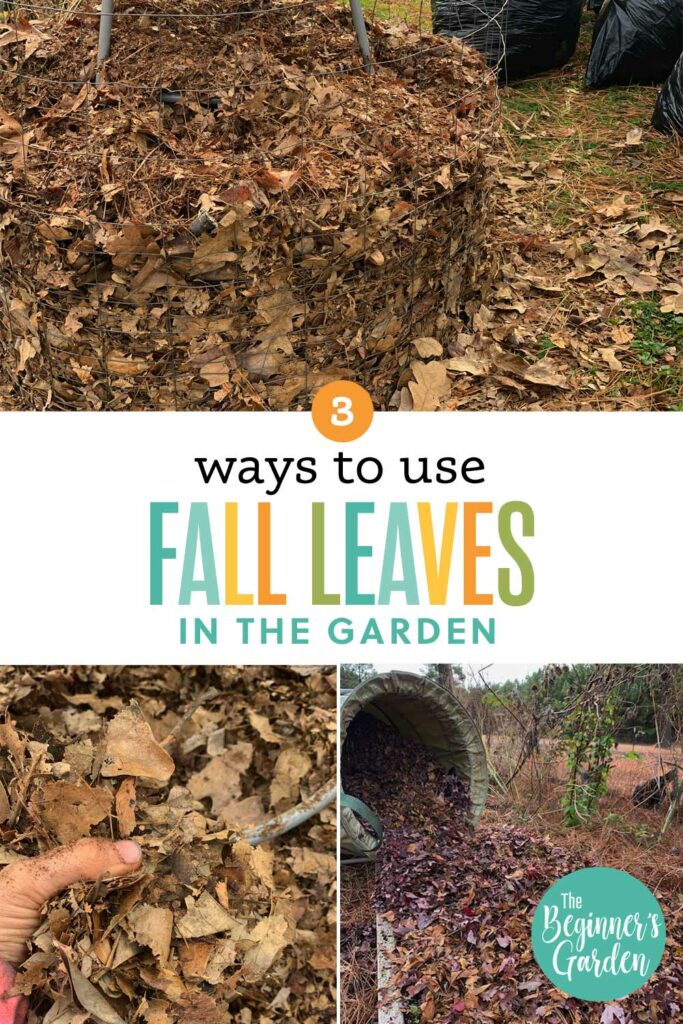How to Use Fall Leaves in the Garden
Do you have an abundance of deciduous autumn leaves? Or maybe you could “rescue” fall leaves from going to the landfill? If so, you will have found what might be considered a “gold mine” for your garden.
We’ve seen the wonders of compost. And we know the benefits of mulch. But if there’s a natural garden amendment that comes in at a close third place — and can serve a similar function as both compost AND mulch — all gardeners should be working to get this in our gardens!
Benefits of Fall Leaves for the Vegetable Garden
The benefits autumn leaves can provide your vegetable garden are many. First, they provide organic matter, which feeds earthworms and microbial life and buffers soil pH extremes. Fall leaves also serve as a soil conditioner. If your soil naturally tends to the clay or sandy or rocky side, over time, leaves can help remediate poor soil texture.

Leaves do provide a small amount of plant nutrients as well like potassium, calcium, phosphorus, magnesium, and boron. But don’t rely on fall leaves for all the plant nutrients your garden needs; nitrogen and potassium levels generally hover at a level of around 0.5 to 1%, while leaves only contribute 0.1% phosphate.

If we think about it, using fall leaves in our garden is akin to mimicking nature’s own process. Some of the most rich and healthy soils occur in forests where leaves fall and build soil over years and decades. Trees themselves mine the deep soil for minerals, and when we use those leaves in our gardens, our plants can benefit.
But how do we actually USE fall leaves in our gardens? Depending on your preference, you have three options.
How to Use Autumn Leaves in Your Compost Pile
The first way you can use fall leaves is to add them to your compost pile. The reason this works is that leaves provide a rich carbon source to your compost pile. Many home gardeners have ample nitrogen sources in the form of kitchen scraps, grass clippings, and chicken manure. But too much nitrogen can hinder the composting process. Enter fallen leaves.
Leaves themselves also benefit from nitrogen in a home compost environment because they are high in carbon and thus slow to break down on their own. Adding nitrogen speeds up the composting process.
While I’m an admitted “lazy composter,” (which means I just pile everything together and wait for it to break down), if you want to turn your compost inputs with fallen leaves into finished compost quicker, use the following method:
- Place a 6-8″ layer of leaves at the bottom of your compost pile, ideally 3-4′ in diameter.
- Add a 1″ layer of nitrogen source or a mixture of compost and manure
- Sprinkle in soil from your garden to introduce microbial life that will activate the composting process
- Water lightly until ingredients are damp, but not soaked
- Continue layering until pile is 3-5 feet high
- Stir every two weeks (give or take) to keep oxygen in the pile

Keep in mind that like all composting, this process will be slower in cool weather. Expect it to take several months in the fall and winter. But by starting in the fall, it should be close to ready when planting time comes in the spring.
How to Use Composted Leaves in the Garden
When you add fall leaves to your compost pile, you can generally use the finished compost just as you would any other compost. Add to the top of the soil or mix into the top layer. If the compost has a fine tilth, you can plant seeds directly into the compost; if the compost is more coarse, use as a mulch.
How to Make and Use Leaf Mold Compost in Your Garden
If the idea of making compost from your fallen leaves seems a bit too labor intensive, you may look for a more hands-off way to use fallen leaves for your garden. In this case, letting leaves turn to “leaf mold compost” is your answer.
Unlike normal composting, which is a faster, bacterial-driven process, leaf mold compost is fungal driven. Don’t let “fungal” deter you. Sure, fungal diseases can be a gardener’s thorn in the side, but this type of fungal decomposition is actually a good thing.
What you trade in labor, though, you pay in time. While bacterial-driven compost can take only months, fungal-driven leaf mold compost can take 1-2 years. Shredded leaves can turn to leaf mold compost in a year or so; whole leaves can take 2 years or longer.

Understanding that this process is a slower one, here are the steps to making leaf mold compost:
- Shred leaves if desired (see below on options)
- Place leaves in a wire bin, container, or bags.
- Keep leaves damp by leaving open to rainfall or irrigating during dry periods
You will know that the leaves have turned to leaf mold when they change into a fine texture, with particle sizes similar to that of soil.

How to Use Leaf Mold Compost in the Garden
Fall leaves that have been left to turn to leaf mold can be used directly into the garden in any way you prefer. You can add it to the top as a mulch or turn it into the soil as a soil conditioner. If your soil has texture issues, you can use a broadfork (Amazon affiliate link) to create channels in the soil and the leaf mold compost can be added to it. Though I prefer not to till my soil, you could till it into the soil.
How to Use Fall Leaves Directly in Your Garden
Perhaps you would like to skip the hands-on composting process and you don’t want to wait 1-2 years (or more) to use your fall leaves in your garden. Is there another option? Thankfully, yes, but this is best done in the fall as you are collecting leaves.
First, I highly recommend shredding the leaves first.

How to Shred Fall Leaves for Use in the Garden
Shredded leaves break down faster and don’t blow away easily. Also, shredded leaves are generally preferred — especially if you use them around perennial plants — over whole leaves because whole leaves can matte and actually repel water. So, what are your options for shredding your leaves?
Option 1: Use a Lawn Mower
If you have a lawn mower, and even better, if your mower has a bagger attachment, you can simply mow over the leaves to shred them. Collect them by raking if you don’t have a bagger attachment. Joe Lamp’l uses this method in his garden as described here.
Option 2: Use a Garbage Can and Weed Whacker
Another option is to dump your leaves into a clean garbage can and insert a weed whacker into the can as you would use an immersion blender. Gary Pilarchik at the Rusted Garden demonstrates this at about the 2:30 mark in this video.
Option 3: Use a Leaf Shredder
Unfortunately, neither of those options worked for me, for various reasons, so I bought a leaf shredder (Amazon affiliate link), and I haven’t looked back.
Though it was an initial investment, this has been one of the best garden investments I’ve made. It makes shredding large quantities of leaves a simple task, and over time it has easily paid for itself in what I’ve saved in purchasing mulch.
How to Use Fresh Shredded Leaves Directly in the Garden
Once you shred your leaves, you can add them directly to the top of your garden soil, up to a depth of 3-6 inches. You can use them as mulch anytime, even if you’re actively growing in the area. When they stay on top, they will slowly decompose and will not tie up nitrogen below the soil.

One thing to note if you lay shredded leaves directly on your soil in the fall is that you may want to rake the top layer aside as spring arrives. The leaves will insulate the soil, preventing the warm-up of the soil temperature that you want for good germination. Plus, if you are directly sowing seed in that area, you don’t want to sow seeds into the leaves. Rake aside the mulch a few weeks ahead of planting time to warm the soil, plant the seeds, and replace the leaves after the plants are 3-6″ high.
If you’re heading into winter and you don’t have crops growing in your garden, you can mix shredded leaves into the garden soil directly. By spring, the leaves will have broken down enough to have mixed into the soil nicely. I would avoid mixing freshly shredded leaves into the soil if you plan on growing in it within 4-6 months. It needs time to break down first.
Another option is if you’re filling new raised beds, leaves (shredded or not) are a great addition to the bottom of a new raised bed. As the leaves decompose, they will add wonderful tilth and texture to your beds and will draw in earthworms.
Fall Leaves are Worth the Effort
Having been using fall leaves in my garden for a few years, I can tell you I already see the benefit. I know, though, that leaves are the gift that will keep on giving. So if you have access to leaves, use them in any of the ways described here to add health and vitality to your garden for next season and years to come!
Do you get overwhelmed with garden planning?

Subscribe here for my best tips to plan your garden in just 7 days -- all for FREE.
Plus, I'll send you my "In the Garden E-mail" on Fridays, periodic updates on garden resources relevant to you, and you'll receive access to my entire bank of free garden downloads!
You are also agreeing to our privacy policy.


Here in South Eastern Michigan we have a relatively short growing season. This year I had a bountiful crop of tomatoes, any suggestions as to what I can do with green tomatoes other than frying them?
I did something different this year, I used the milk jug garden method to grow all my plants from seed, I was extremely successful.
I’ve seen people here use them to can salsa verde. Glad the milk jug method worked for you!